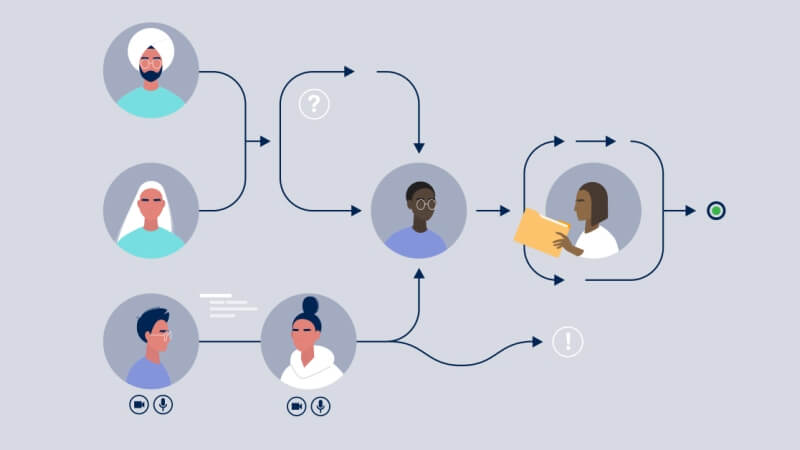Strong teams are at the core of what makes a business successful. Innovative products, solid plans, and a visionary strategy can only go so far without a team to bring them to life. For this reason, organizations have spent significant time and energy in trying to understand and optimize team performance.
As it turns out, it’s relatively easy to define what makes a high-performing team. It’s a lot harder to achieve it. Here are five characteristics that high-performing teams share, and ways that you can foster these qualities in your own teams:
1. Awareness
A high-performing team and each of its members have high levels of self-awareness, meaning that they understand themselves and one another. This awareness can be related to understanding your own strengths and weaknesses, as well as understanding the strengths and weaknesses of your colleagues. It can also refer to the more social side of work – perhaps your coworker Robert likes to work alone more often with fewer distractions, while your coworker Hannah likes to work by bouncing ideas off her coworkers. Understanding how each individual team member approaches work can help the team optimize how it structures the responsibilities and interdependencies within the team.
Tips for building awareness:
One way to build awareness is to give every team member access to a team assessment that they can use to learn more about themselves and others. For example, Criteria’s Talent Insights tool uses a personality assessment to provide each team member with insight about their work, communication, and interaction style. For individuals, this builds awareness about themselves and about their teammates. And for managers and leaders, it gives them an understanding of the work styles of each individual team member and also provides insight into how different team members may interact with each other.
2. Engagement
A high-performing team has members that are highly engaged with the organization and their work. This means they have high rates of participation, collaboration, and all members work to make sure everyone is involved and contributing. Not only does high engagement give each individual team member a more empowered, purpose-driven experience, but it also ensures that each team member’s strengths are being utilized to the fullest.
Tips for building engagement:
At the organizational level, engagement can be built in a number of ways – for example, clear onboarding, professional development opportunities, efficient operations and processes, and a fair and equitable approach to rewarding and recognizing employee achievements. At the team level, many of these concepts are equally important, but it’s also important to use proper tools to enable collaboration and to ensure that the team’s projects are purpose-driven and are clearly tied to the company’s overall strategy.
3. Communication
Communication is a big and obvious element of a high-performing team. This means teams communicate consistently, with transparency, and work towards identifying and resolving conflict effectively. Strong communication helps the team operate more efficiently in a coordinated way.
Tips for building communication:
In order to foster communication, a modern team needs the proper tools to communicate and collaborate, as well as guidelines for when to use those tools. Email is a big one that every organization uses, but there are other tools with different use-cases: chat tools, intranets, employee recognition software, project management software, internal ticketing, general distribution email lists, and more. The goal is to provide enough communication channels for every use case, and to ensure that the guidelines for how to use each are clear and intuitive. It also means encouraging communication without fear of being shot down or being embarrassed for asking a question.
4. Trust
Trust means that employees are comfortable making mistakes, giving one another feedback, taking risks, and learning from one another. Trust and psychological safety are so critical to team success because they enable teams to innovate, push ideas further, and produce the best result – as opposed to sticking to the status quo, giving in to group-think, or even being afraid to call out bad behavior on the team. Trust is also crucial for making communication and engagement a reality.
Tips for building trust:
Trust is difficult to build directly, but a good first step is to tackle the “awareness” part of the equation. Building shared understanding about each team member can help them understand each other when conflicts do arise. Another major element of trust is to demonstrate fairness to the team – fairness in who gets promoted, fairness in who gets which project, fairness in who is listened to. Seeing that fairness play out can help team members trust each other and their managers.
5. Balanced
Finally, high-performing teams are balanced. They have a balance of personalities, backgrounds, communication styles, expertise, and roles within the team. Balance is so important because it helps the team avoid group-think, which can lead to mediocre outcomes. Balance also helps teams innovate new ideas and apply their different strengths to accomplish big goals. After all, diverse workforces are proven to lead to more productive teams that drive bigger results.
Tips for building balanced teams:
Unlike the other four characteristics, balance is largely built in the hiring process. Building a balanced team comes down to how a leader selects new team members. When hiring new team members, leaders should look to fill in gaps in the existing team in order to bring in new expertise and new perspectives. This also means that leaders should avoid relying too heavily on “culture fit” to make a new hire. New hires should be able to get along with existing team members, but they do not need to fit the “mold” of existing team members in order to be successful.





